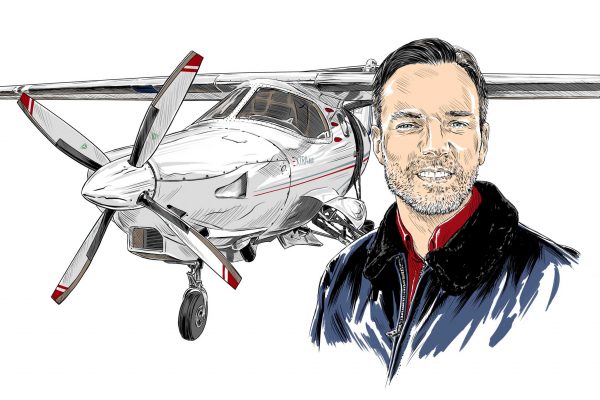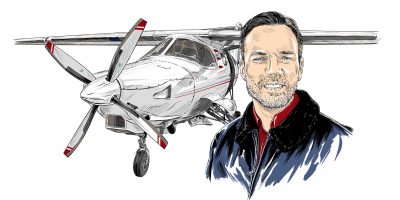The first post-Brexit changes to UK aviation regulations are now with us. The Aviation Safety (Amendment) Regulations 2021, as sponsored by the CAA and Department for Transport, have now made it through Parliamentary procedure and into law. They amend the UK versions of the Standardised European Rules of the Air (Part-SERA) and the Aircrew Regulation (including the Balloon and Sailplane licensing regulations), as were adopted in UK law from 1 January 2021.
There are two changes, one is to reintroduce on the 20 May the ‘clear of cloud’ rule when operating VFR at or below 3,000ft amsl in Class D airspace, and the other is to continue to allow the use of Part-FCL licences with a pilot medical declaration when flying Part-21 (formerly EASA) aircraft.
Starting with medicals, originally in 2016 the pilot medical declaration was only applicable to national licences issued under the Air Navigation Order (ANO) and when flying non-EASA (now non-Part-21) aircraft. A while later this was extended by exemption to allow pilots with Part-FCL licences and a PMD to fly UK-registered EASA (now Part-21) aircraft as well. The amendment here makes the exemption permanent – giving licence holders certainty that the combination will be valid in the future.
“The amendment means Part-FCL licence holders can fly UK-registered EASA (now Part-21) aircraft with a pilot medical declaration”
Moving onto SERA, I have a somewhat sense of déjà vu – a year ago this column discussed the end of the UK ‘clear of cloud’ rule in Class D airspace. In March 2020, despite having technically left the EU in January, the transitional exit arrangements were such that when the European Commission no longer allowed an exemption to the Part-SERA VMC minima in Class D airspace, the UK had no choice but to comply. This ended a UK rule that had existed since 1994 and instead aligned us with the standard ICAO minima.
It seems totemic that one of the first post-Brexit changes to make its way through the legislative system is reverting the UK back to the previous rule. As was the case prior to March 2020, the change only applies in UK airspace – in Europe and indeed most of the rest of the world, the standard ICAO minima apply. The reason for 20 May rather than sooner is that ATC units need time to rewrite procedures and do a bit of training – this might seem like a long time for a minor change, but ATC operate under strict procedures which are documented to a high degree of detail.
Now, even normally it is debatable how much precise VMC minima matters in practice, but if in an idle lockdown moment, you feel like refreshing your memory of the subject, read on.
The standard ICAO and SERA VMC minima for Classes A-E when below 10,000ft are 5km inflight visibility and clear of cloud by 1,000ft vertically and 1500m horizontally. Prior to SERA, under the UK Rules of the Air there was also a sub-rule that in Classes C, D and E you were deemed to have complied with the standard VMC minima if you were at or below 3,000ft amsl, clear of cloud, surface in sight, 5km in flight visibility (helicopters were allowed 1500m) and 140kt indicated airspeed or less. When Part-SERA came in around 2014 the UK rule persisted as an exemption until March 2020, becoming limited to Class D more recently.
The reversion of the rule is only for Class D airspace. For me this makes sense – I am not sure there is any Class C airspace below 3,000ft in the UK and the safety case for being just ‘clear of cloud’ in Class E is weak. Remember in Class E there is no requirement for VFR traffic to be in contact with ATC, unlike for IFR. Having a cloud clearance requirement in Class E does make sense to reduce the likelihood of IFR traffic coming face to face with an unknown VFR right on the edge of a cloud. It is also worth remembering that despite the UK rule, the basic logic of the ICAO standard is similar in Class D – while VFR requires an ATC clearance, formal separation of traffic is not required, therefore ATC may rely on traffic visually avoiding each other in some circumstances.
The rest of SERA in the UK remains unchanged. Special VFR is still ICAO standard, although effectively the UK rule builds elements of what would be Special VFR in the normal ICAO ruleset into the basic VMC minima. With the UK rule back, there will be limited circumstances in which fixed wing pilots need to think about SVFR but remember under SERA there is also a VFR requirement for a 1,500ft cloud ceiling and 5km ground visibility when arriving or departing an aerodrome in a CTR. Under a SVFR clearance this goes down to 1,500m flight visibility (800m for helicopters) and cloud ceiling of 600ft – worth remembering if for example you ever need to get out of an aerodrome within a CTR and the cloud ceiling is sub-1,500ft.
No doubt there will be more post-Brexit changes to come, for example national licence holders may soon be permitted to fly Part-21 (formerly EASA) aircraft, although the nature of the retained EU law and the Withdrawal Act 2018 does not make it as easy to do from a legal point of view as one might think, even though we have now left the EU.




